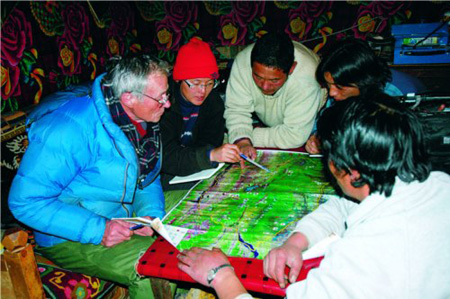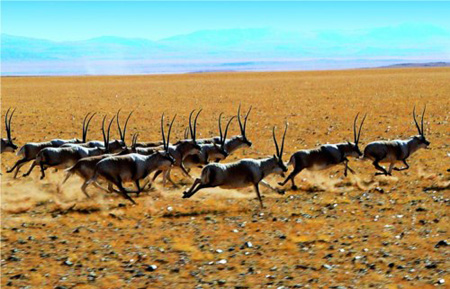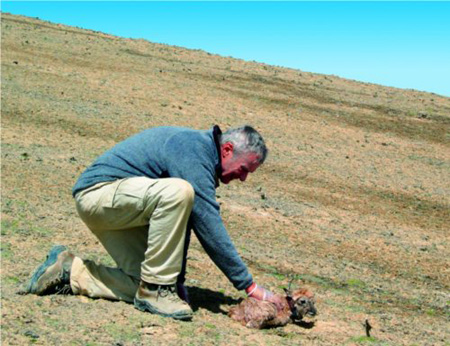American naturalist's story of Tibetan antelopes
2009-08-14 19:45 BJT
By Zhang Mingyu

Dr. Schaller (L) works with local staff on wildlife protection in Tibet. (Photo Source: China‘s Tibet)
BEIJING, Aug. 13 (Xinhuanet) -- Two decades ago, George Beals Schaller talked about Tibet and an endangered plateau animal the Tibetan antelope, or Chiru, at a luncheon party held by a fashion circle in a way to raise funds to boost wildlife protection in China.
At the party, the audience was so fascinated by his vivid pictures displaying the antelopes in their natural habitation: a large-scale migration, a doe nursing its children, and a buck with elongated black horns walking freely on the northern Tibet‘s Changtang grassland.
Schaller, 76, an American zoologist, is the vice-president of the Science and Exploration Program at the International Wildlife Conservation Society.
Having studied wildlife in Africa, Asia and South America, he was also the first western scientist commissioned by the World Wildlife Fund to work in China.
However, to the delicate audience, Schaller also showed a number of shocking pictures -- skeletons of Tibetan antelopes piling up around the poachers‘ tents and their furs peeled off on the ground!

Photo shows a flock of Tibetan antelopes running on grassland. (Photo Source: China‘s Tibet)
According to Schaller, the Tibetan antelope‘s pashm, considered the world‘s finest of its kind, was often smuggled to Kashmir, where it was made into "shahtoosh," a Persian shawl meaning "the King of cashmere."
"As soon as I mentioned the word ‘shahtoosh,‘ some ladies took off their shawls quietly. Before this party, they hadn‘t been aware that what they wore over their shoulders was made of wool of three to five Tibetan antelopes. They only knew a soft shawl symbolizing a vogue was expensive and might cost as much as 15,000 U.S. dollars," said Schaller.
In 1985, Schaller saw the Tibetan antelopes for the first time when conducting field survey in Qinghai Province. Till then, his knowledge about it was no more than a plateau rare species mostly populating the areas at an altitude of 4,300-5,000 m.
Driven by curiosity about the wildlife on the Qinghai Plateau, Schaller began research on the animal. In Changtang, he met people who had the same goal of environment protection, including forestry professionals from Tibet, Xinjiang and Qinghai as well as experts in plateau biological research.
"In early 1790s, some travelers had witnessed a flock of 15,000-20,000 Tibetan antelopes during their journey in Tibet. I supposed there were over one million of them inhabiting this region then."

Schaller takes care of a baby Tibetan antelope. (Photo Source: China‘s Tibet)
However, ruthless trophy hunting for the animal‘s warm, soft and fine wool became rampant in the late 1980s, causing its population sharply declined. Official conservative data showed that about 20,000 Tibetan antelopes were killed each year.
"Poachers drove from Xining (capital of Qinghai Province) to Hoh Xil (the major inhabited area for Tibetan antelopes) and then hunted the antelopes during their breeding season or chased them by motorcycle until they were exhausted to death."
An anti-poaching team led once seized a vehicle carrying 600 Chiru furs. Similar cases were discovered in Xinjiang, too. Schaller said only in 1992, it was estimated that at least 2,000 kg of Tibetan antelope pashm were transported to India.

 Mail
Mail Share
Share Print
Print


 Video
Video









 2009 China Central Television. All Rights Reserved
2009 China Central Television. All Rights Reserved